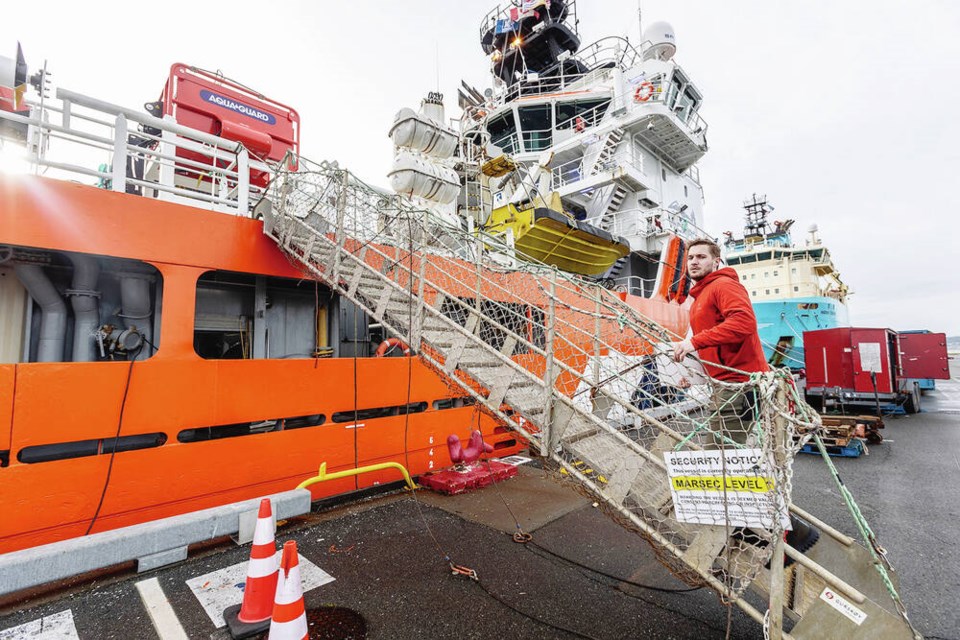A quick-response offshore supply vessel billed as Canada’s largest spill-response ship is being readied at Ogden Point for deployment early in the new year.
The 244-foot-long K.J. Gardner is in Victoria after sailing from Rotterdam in the Netherlands to start its new job working off B.C.’s coast, responding to oil spills and other disasters.
It will be based at Beecher Bay along with other smaller spill-response vessels that are part of Western Canada Marine Response, an industry-funded, Transport Canada-certified organization.
The K.J. Gardner is the final piece of the marine response group’s program to prepare for the Trans Mountain Expansion pipeline, now under construction, said Michael Lowry, spokesman for Western Canada Marine Response.
The group has 2,300 members and close to 90 response vessels on B.C.’s coast.
Built in 2009 in Norway, the vessel is owned by KOTUG Canada, a partnership between KOTUG International B.V. and Horizon Maritime Inc. of Canada. KOTUG Canada has a partnership with the Scia’new First Nation, owner of the Beecher Bay berthing site.
The marine response group is leasing the K.J. Gardner, and will be directing the KOTUG Canada crew, including two Scia’new First Nation members.
The vessel, which can respond to an area from the Port of Vancouver to Port Renfrew, is packed with new spill-response equipment valued at about $6 million, said Lowry, adding Trans Mountain paid for the equipment as part of its commitment to oil-spill response.
One key feature is its ability to reach international shipping lanes within one to six hours at the outside. The faster ships can reach a spill site, the faster a spill can be contained.
Marine-response ships need to have enough equipment to handle an initial spill of 2,500 tonnes. “This boat helps us meet that requirement,” said Lowry, noting the vessel can hold up to 1,000 tonnes of oil.
Scia’new elected Chief Russ Chipps said the maximum six-hour response time was set because of concerns from nation members that longer response times could have a drastic impact. “We figured the damage would be done. Our food would be lost. We are the salmon people.”
Having the largest spill-containment ship in the country and quicker response times addresses the nation’s desire to see the waters protected, he said.
The nation also has an ocean resource team in Beecher Bay, Chipps said. “We want to be the centre for research development and protection of the ocean. We want to be be there at the start of anything new that happens on the ocean and maintain that ocean.”
Having the biggest oil-spill-response vessel in Canada based at Beecher Bay is a “real source of pride” as the nation’s children grow up with a legacy of protecting the ocean, Chipps said.
Kyle Hujdic, base operations manager for the marine-response organization at Beecher Bay, said when the vessel is called out, its primary task will be containing the source of the spill.
It carries 4,000 feet of containment booms and will be able to take away large quantities of oil. It has skimmers, can pump oil and has a class-leading sweeping system, he said.
Up on the bridge, Chief Officer Serguei Koutaitsev said a dozen crew members are on board at one time in a 28-day rotation.
The ship has travelled internationally waiting for the B.C. contract to begin.
It was in drydock in Norway, and has installed windmills offshore of Scotland and towed icebergs off Canada’s east coast.
A powerful vessel weighing 2,800 gross tonnes, the K.J. Gardner can pull 200 tonnes, he said, and is prepared for rough weather. Even if half the ships’s thrusters went down, the vessel would be able to maintain its position, he said.



